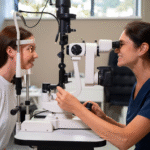In today’s digital world, most of us spend hours staring at screens — whether it’s computers at work, smartphones in our hands, or televisions at home. While technology makes life easier, our eyes often pay the price. Prolonged screen use can cause discomfort, eye strain, blurred vision, and even long-term vision issues if not managed properly.
This article will guide you through practical eye care tips for people who use screens daily. It’s written in an easy-to-understand way so you can take simple steps to protect your eyes and enjoy healthier vision in the long run.
Why Screen Time Affects Your Eyes
Screens emit blue light and require your eyes to focus for extended periods, which can cause digital eye strain (sometimes called computer vision syndrome). Common symptoms include:
- Dry or irritated eyes
- Blurred or double vision
- Headaches
- Difficulty focusing
- Neck and shoulder pain (from posture issues while looking at screens)
When you blink less often while focusing on a screen, your eyes dry out quickly. Add poor posture and bad lighting to the mix, and your eyes end up working much harder than they should.
1. Follow the 20-20-20 Rule
One of the easiest and most effective eye care tips is the 20-20-20 rule. It helps relax your eye muscles and reduce strain. Here’s how it works:
- Every 20 minutes of screen time
- Look at an object 20 feet away
- For at least 20 seconds
This simple habit gives your eyes a mini-break and prevents overexertion. If you struggle to remember, set an alarm or download reminder apps that notify you to take breaks.
2. Adjust Your Screen Settings
Your device’s brightness, contrast, and font size matter more than you think. Wrong settings make your eyes work harder.
- Brightness: Match your screen brightness to the light around you. If your screen glows like a lightbulb in a dark room, it’s too bright.
- Text size: Increase text size so you don’t have to squint.
- Blue light filter: Turn on the blue light filter or “night mode” available on most devices. It reduces blue light exposure, especially at night.
Proper settings can significantly lower the risk of headaches and strain.
3. Keep the Right Distance and Angle
The way you sit in front of your screen affects eye comfort. Ideally:
- Place your monitor about 20–24 inches away from your eyes (roughly arm’s length).
- The top of the screen should be at or slightly below eye level so you naturally look down a little.
- Avoid tilting your head too much — keep your neck and shoulders relaxed.
For smartphone users, try to hold the device slightly below eye level instead of too close to your face.
4. Blink More Often
Did you know people blink about 15–20 times a minute normally but only around 5–7 times when staring at screens? This reduced blinking dries out your eyes, causing irritation and redness.
To fix this:
- Make a conscious effort to blink often.
- Practice “full blinks” where your eyelids completely close, spreading moisture evenly across your eyes.
- Use artificial tears (eye drops) if dryness continues.
5. Use Proper Lighting
Poor lighting makes screen time worse. If the room is too dim or too bright, your eyes strain harder to adjust.
- Avoid glare from windows or overhead lights — position your screen sideways to a window, not directly in front or behind it.
- Use an anti-glare screen protector.
- Choose soft, warm lighting rather than harsh fluorescent lights.
Balanced lighting reduces glare and keeps your eyes comfortable.
6. Maintain Good Posture
You might think posture is about your back and neck, but it’s also linked to eye health. When you slouch or lean in too close, your eyes strain harder.
- Sit upright with feet flat on the floor.
- Keep your screen at the right height.
- Take stretching breaks to avoid stiffness.
Proper posture improves blood circulation, which benefits both your eyes and overall health.
7. Eat a Vision-Friendly Diet
What you eat plays a big role in eye health. Include foods rich in:
- Vitamin A (carrots, sweet potatoes) – protects the cornea
- Omega-3 fatty acids (salmon, chia seeds, walnuts) – prevents dry eyes
- Vitamin C (citrus fruits, bell peppers) – reduces risk of cataracts
- Lutein and zeaxanthin (spinach, kale, eggs) – protect against harmful blue light
A balanced diet keeps your eyes nourished and strong.
8. Stay Hydrated
Dehydration can make dry eyes worse. Drink plenty of water throughout the day, especially if you spend long hours in air-conditioned rooms, which can dry the air and irritate your eyes.
9. Wear Computer Glasses
If you use screens daily, consider computer glasses. These are special glasses designed with anti-reflective and blue light–blocking coatings. They reduce glare and eye strain, especially for people who spend more than 6–8 hours on digital devices.
10. Get Regular Eye Checkups
Even if you don’t have vision problems, regular eye exams are important. An eye doctor can:
- Detect early signs of strain or vision problems
- Recommend suitable glasses or lenses
- Provide guidance on screen use habits
For people who use screens daily, yearly checkups are highly recommended.
Quick Table: Do’s and Don’ts for Screen Users
| Do’s | Don’ts |
|---|---|
| Follow the 20-20-20 rule | Stare at screens for hours without breaks |
| Adjust brightness and text size | Keep screens too close to your eyes |
| Sit at the right distance and posture | Slouch or strain your neck while working |
| Eat vision-friendly foods | Rely only on junk food with no nutrients |
| Get regular eye exams | Ignore persistent eye discomfort |
Final Thoughts
Screens are part of our daily lives, but they don’t have to harm our eyes. By following simple habits like the 20-20-20 rule, blinking more often, adjusting your screen settings, and eating a healthy diet, you can protect your vision while still enjoying the digital world.
Remember: your eyes are precious, and caring for them today will prevent bigger problems tomorrow.
FAQs About Eye Care for Screen Users
1. How many hours of screen time is safe for eyes?
Experts recommend limiting recreational screen time to 2–3 hours daily. However, if your work requires longer usage, take frequent breaks and follow eye care practices.
2. Do blue light glasses really work?
Yes, blue light–blocking glasses can reduce glare and digital eye strain, especially during extended computer use. However, they don’t replace good screen habits.
3. Can too much screen time permanently damage eyes?
Excessive screen use doesn’t usually cause permanent blindness, but it can lead to chronic dry eyes, eye strain, and worsening of existing vision problems if ignored.
4. How often should I see an eye doctor if I use screens daily?
At least once a year. If you experience persistent headaches, blurred vision, or dry eyes, schedule a checkup sooner.
5. Are eye exercises helpful for screen users?
Yes. Simple exercises like focusing on distant objects, rolling your eyes gently, and practicing the 20-20-20 rule can relax eye muscles and reduce fatigue.



